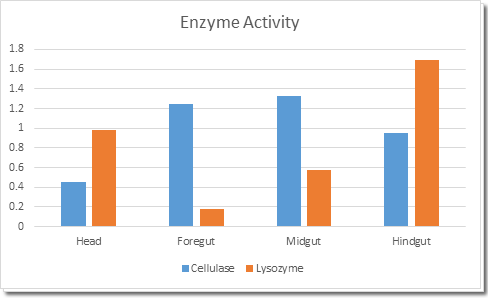TERMITES
Bait attractiveness
Our experiment shows that the bait we use is strongly attractive to termites. When facing with baits and normal wood, termites will always choose our baits. This ensure that our device will successfully attract the termites even there is many other food.



Fig 1. Wood powder has been placed in the petri dish for 10 min. (A) 0 min after baits added. (B) 1 min after baits added. Termites begin to move to the baits. (C) 5 min after baits added. Most termites are surrounding around the baits.
Chosen compound toxicity verification
We prove that Avermectin and the mix of our toxic protein are both toxic to termites. Using the Streptomyces and TT01, the Avermectin seems to work better.


Fig 2. Toxicity verification of Avermectin and toxic protein. Avermectin works well at killing termites.
Cellulase and lysozyme activity measurement
When worker termites are taking the food back to their nest, they will keep the food in their mouth. According to our result, the cellulase activity in termites’ head is relatively low. This guarantees that our CNC coat will not be totally digested for a certain period of time. The relative high cellulase and lysozyme activity in gut ensure that our coated bacteria will be digested when finally eaten.

Fig 3. Cellulase and lysozyme acticity in different parts of termites gut.
Verification of the release delay effect due to the CNC capsulation
After the CNC capsulation, the termites will not die as soon as before because they need to digest the CNC coat first. This results in a period of time for termites to conduct trophallaxis.

Fig 4. CNC capsulated Streptomyces toxicity compared with the no capsulated one.
Trophallaxis verification

Fig 5. The leftmost termite arrow pointed is the normal termite. Other termites with arrows indicates the blue dyed termites.

Fig 6. Dyeing for two days. Workers termites become extremely blue. Meanwhile, soldiers become blue. This indicates that trophallaxis has been carried out.

Fig 7. A blue soldier termites are placed with two red worker termites (cannot see in this picture). Red staining food are also provide. Three days after, the soldier shows a little bit red color (the lower one). The control one added is still really blue.
Gene modified product effectiveness measurement
We have successfully expressed the toxic protein in E.coli. Using E.coli, we test the toxic protein toxicity again. This time, toxic protein shows a strong effectiveness to kill termites.

Fig 8. Toxicity verification of modified E.coli.














